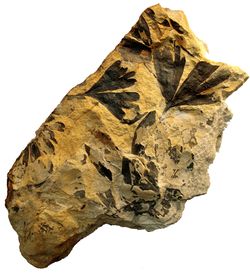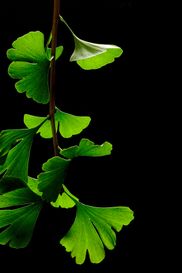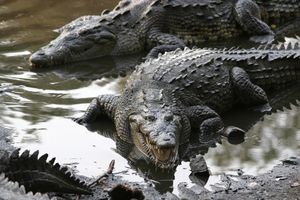أحفورة حية
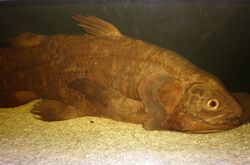
أسماك السيلاكانث يعتقد أنها انقرضت منذ 65 مليون سنة مضت، حتى اكتشفت عينة حية من هذه الرتبة عام 1938.
الأحفورة الحية living fossil، هي أنواع (أو سلالات) من العضيات تبدو كما لو أنها هي نفسها من أنواع غير معروفة إلا من الأحفورات وليس لها أقارب أحياء. عايشت هذه الأنواع جميع أحداث الانقراض الجماعي، وتحتفظ عموماً بتنوع تصنيفي منخفض. والنوع الذي يشع بنجاح (مُشكـِّلاً العديد من الأنواع الجديدة بعد عنق زجاجة جيني محتمل) يصبح أنجح من أن يوصف بأنه "أحفورة حية".
نظرة عامة
گينكو أحفوري وحي
نبات گينكو بايلوبا حي
التاريخ
تعريفات أخرى
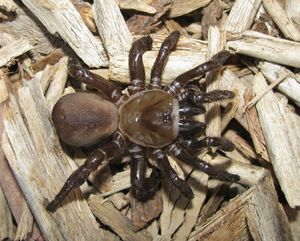
The trapdoor spider has segmented plates on its back, making it the most ancient of all living spiders and the closest relative to the scorpions in the spider family.
أمثلة
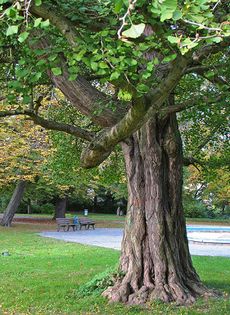
Ginkgos have not only existed on this planet for a long time, but also have a long life span, with some having an age of over 2,500 years. Six specimens have even been known to survive the atomic bombing of Hiroshima, 1 to 2 kilometers from ground zero; they still live there today.
بعض الأمثلة المعروفة غير رسمياً "كأحفورات حية".
جراثيم
- Stromatolite, a layered structure created as sediment is trapped by shallow-water, oxygen-creating, blue-green bacteria
نباتات
- Amborellaceae – a plant from New Caledonia, possibly closest to base of the flowering plants
- Araucaria araucana – the Monkey Puzzle tree
- Cycads
- Ginkgo tree (Ginkgoaceae)
- Horsetails – Equisetum (Equisetaceae)
- Metasequoia – Dawn Redwood (Cupressaceae; a borderline example, related to Sequoia and Sequoiadendron)
- Sciadopitys tree (Sciadopityaceae)
- Liquidambar – tree (Altingiaceae)
- Whisk ferns – Psilotum (Psilotaceae)
- Welwitschia (Welwitschiaceae)
- Wollemia tree (Araucariaceae – a borderline example, related to Agathis and Araucaria)[1][2]
فطريات
حيوانات
- الفقاريات
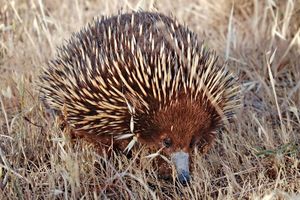 Echidnas are one of few mammals to lay eggs.
Echidnas are one of few mammals to lay eggs.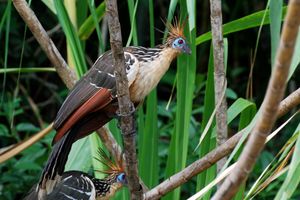 Hoatzin are born with two visible claws on their wings, but they fall out once they reach maturity.
Hoatzin are born with two visible claws on their wings, but they fall out once they reach maturity.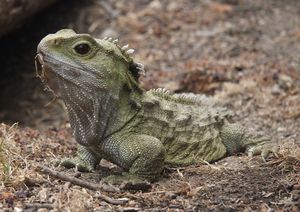 Tuataras are reptiles, yet retain more primitive characteristics than lizards and snakes.
Tuataras are reptiles, yet retain more primitive characteristics than lizards and snakes.- ثدييات
- Aardvark (Orycteropus afer)
- Amami rabbit (Pentalagus furnessi)
- Chevrotain (Tragulidae)
- Cypriot mouse (Mus cypriacus)
- Elephant shrew (Macroscelidea)
- Laotian Rock Rat (Laonastes aenigmamus)
- Iriomote cat (Prionailurus iriomotensis)
- Monito del Monte (Dromiciops gliroides)
- Monotremes (the platypus and echidna)
- Mountain beaver (Aplodontia rufa)
- Okapi (Okapia johnstoni)[3]
- Opossums (Didelphidae)
- Capybara (Hydrochoerus hydrochaeris)
- Asian Elephant (Elephas maximus)
- Przewalski's horse (Equus przewalskii)
- Pygmy Hippo (Choeropsis liberiensis)
- Pygmy right whale (Caperea marginata)
- Red Panda (Ailurus fulgens)
- Solenodon (Solenodon cubanus and Solenodon paradoxus)
- Shrew Opossum (Caenolestidae)
- Sumatran Rhinoceros (Dicerorhinus sumatrensis)
- طيور
- Pelicans have been virtually unchanged since the Eocene, and are noted to have been even more conservative across the Cenozoic than crocodiles[4]
- Acanthisittidae (New Zealand "wrens") – 2 living species, a few more recently extinct. Distinct lineage of عصفوريات.
- Broad-billed Sapayoa (Sapayoa aenigma) – One living species. Distinct lineage of Tyranni.
- Bearded Reedling (Panurus biarmicus) – One living species. Distinct lineage of Passerida or Sylvioidea.
- Coliiformes (mousebirds) – 6 living species in 2 genera. Distinct lineage of Neoaves.
- Hoatzin (Ophisthocomus hoazin) – One living species. Distinct lineage of Neoaves.
- Magpie Goose (Anseranas semipalmata) – One living species. Distinct lineage of Anseriformes.
- Seriema (Cariamidae) – 2 living species. Distinct lineage Cariamae.
- Andean Condor (Vultur gryphus) and California Condor (Gymnogyps californianus) is a two living members of the New World Vultures.
- Osprey (Pandion haliaetus) and Northern Crested Caracara (Caracara plancus) are two living members of the Raptor family.
- Razorbill (Alca torda) - The closest relative to the now-extinct Great Auk.
- Secretarybird (Sagittarius serpentarius)
- زواحف
- Alligator Snapping Turtle (Macrochelys temminckii)
- Crocodilia (crocodiles, gavials and alligators)
- Pig-nosed turtle (Carettochelys insculpta)
- Snapping Turtle (Chelydra serpentina)
- Tuatara (Sphenodon punctatus and Sphenodon guntheri)
- Amphibians
- Giant salamanders (Cryptobranchus, and Andrias)
- Hula Painted Frog (Latonia nigriventer)[5]
- Purple frog (Nasikabatrachus sahyadrensis)
- Jawless fish
- Hagfish (Myxinidae) Family
- Northern Brook Lamprey (Ichthyomyzon fossor)
- Bony fish
- Arowana and Arapaima (Osteoglossidae)
- Bowfin (Amia calva)
- Coelacanth (the lobed-finned Latimeria menadoensis and Latimeria chalumnae)
- Gar (Lepisosteidae)
- Queensland lungfish (Neoceratodus fosteri)
- Sturgeons and Paddlefish (Acipenseriformes)
- Bichir (Polypteridae) Family
- Protanguilla palau
- Mudskipper (Oxudercinae)
- قروش
- Blind shark (Brachaelurus waddi)
- Bullhead shark (Heterodontus sp.)
- Elephant shark (Callorhinchus milii)
- Frilled shark (Chlamydoselachus sp.)
- Goblin Shark (Mitsukurina owstoni)
- Gulper Shark (Centrophorus sp.)
- ثدييات
- Invertebrates
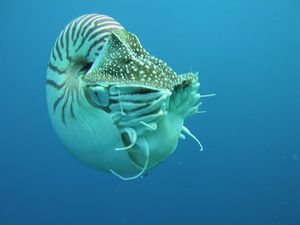 Nautilus still retain the external, spiral shell that its other relatives have lost.
Nautilus still retain the external, spiral shell that its other relatives have lost.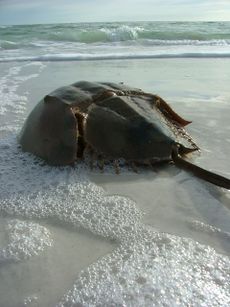 With little change over the last 450 million years, the horseshoe crabs appear as living fossils
With little change over the last 450 million years, the horseshoe crabs appear as living fossils- حشرات
- Mantophasmatodea (gladiators; a few living species)
- Meropeidae (3 living species, 4 extinct)
- Micromalthus debilis (a beetle)
- Mymarommatid wasps (10 living species in genus Palaeomymar)
- Nevrorthidae (3 species-poor genera)
- Notiothauma reedi (a scorpionfly relative)
- Orussidae (parasitic wood wasps; about 70 living species in 16 genera)
- Peloridiidae (peloridiid bugs; fewer than 30 living species in 13 genera)
- Sikhotealinia zhiltzovae (a jurodid beetle)
- Syntexis libocedrii (Anaxyelidae cedar wood wasp)
- Crustaceans
- Glypheoidea (2 living species: Neoglyphea inopinata and Laurentaeglyphea neocaledonica)
- Stomatopods (mantis shrimp)
- Triops cancriformis (also known as tadpole shrimp; a notostracan crustacean)
- رخويات
- لافقاريات أخرى
- Crinoids
- Horseshoe crabs (only 4 living species of the class Xiphosura, family Limulidae: Limulus polyphemus,Tachypleus gigas, Tachypleus tridentatus and Carcinoscorpius rotundicauda)
- Lingula anatina (an inarticulate brachiopod)
- Liphistiidae (trapdoor spiders)
- Onychophorans
- Valdiviathyris quenstedti (a craniforman brachiopod)
- Paleodictyon nodosum (غير معروف)
- حشرات
انظر أيضاً
- رليكت، عضيات كانت تتواجد بأعداد كبيرة وانخفضت أعدادها ومناطق انتشارها.
المصادر
- ^ Chambers, T.C., Drinnan, A.N. & McLoughlin, S. 1998. Some morphological features of Wollemi Pine (Wollemia nobilis: Araucariaceae) and their comparison to Cretaceous plant fossils. International Journal of Plant Science, 159: 160-171.
- ^ McLoughlin S., Vajda V. (2005). "Ancient wollemi pines resurgent". American Scientist. 93: 540–547.
- ^ "Why Is the Okapi Called a Living Fossil". The Milwaukee Journal. Jun. 24, 1954.
{{cite web}}: Check date values in:|date=(help) - ^ http://www.wired.com/wiredscience/2011/03/repost-the-pelicans-beak-success-and-evolutionary-stasis/
- ^ Morelle, Rebecca. "Rediscovered Hula painted frog 'is a living fossil'". BBC News. Retrieved 4 June 2013.
وصلات خارجية
الكلمات الدالة:
This article contains content from Wikimedia licensed under CC BY-SA 4.0. Please comply with the license terms.
